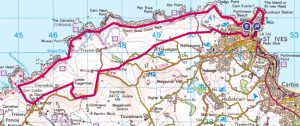
KEY DATA
- Terrain: Substantial ups & downs on coast path, firm going
- Starting point: Albert Rd, St Ives, TR26 2EH
- Distance: 17.8 km (11. 1 miles)
- Time: 5 hrs 45 mins
- OS Map: OS Explorer 102. The map can also be found online at https://explore.osmaps.com/en/route/10642080/Zennor–St-Ives-Cornwall-DH-Lawrence–Virginia-Woolf-
- Facilities: Hotels, restaurants, pubs, shops, toilets
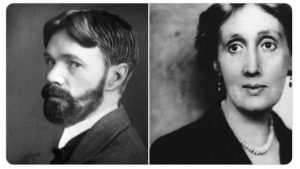
DH LAWRENCE
‘When we came over the shoulder of the wild hill, above the sea, to Zennor, I felt we were coming into the Promised Land.’
D.H. Lawrence and his wife Frieda moved to Cornwall in 1915 and stayed for nearly two years at Tregerthen Cottage. Lawrence completed the manuscript for Women in Love here, so this was an important place for him, somewhere he felt happy and free.
Lawrence was escaping from what he saw as the oppressiveness of London life, and his dream was to set up ‘Rananim’ here, an ideal artistic-philosophical haven of like-minded people in which everyone would live together in perfect harmony. Unfortunately, he wasn’t the easiest person to get on with, and that idea soon floundered; but his love of the mystical beauty of this stretch of Cornish coast never wavered: ‘When we came over the shoulder of the wild hill, above the sea, to Zennor, I felt we were coming into the Promised Land.’
As the war dragged on, anti-German feelings in the county grew, and some of the Cornish people turned against Lawrence and Frieda, who was German-born and a cousin of the German air ace, Baron Manfred von Richthofen. War-time rumours took hold: there was a stock of petrol for German submarines at the bottom of the cliffs near the Lawrences’ cottage: the patterns on the Lawrences’ chimney were a signal for patrolling submarines (the main Atlantic convoy route lay along this coast). They finally received an order to leave the county in October 1917.
VIRGINIA WOOLF
‘Happiness is always measured for her against the memory of being a child in that house’
‘I could fill pages remembering one thing after another that made the summer at St Ives the best beginning to a life conceivable,’ Virginia Woolf wrote. It was here, when she was a child in Talland House, that she spent three months every summer in the 1880s.
The household that Virginia Woolf grew up in was rife with literary and artistic inspiration thanks to her father, Sir Leslie Stephen, an author and critic with a huge circle of influential friends among the literati and emerging St Ives and Newlyn artist colonies. Writers Henry James, George Meredith and James Russell Lowell are just a few of the regular visitors to their St Ives’ home.
Another passion of her father was walking, and they ‘went for a great long walk every afternoon’. For her, walking and writing became inseparable. When she got home from a walk, she ‘had a conception of the world…one’s mind works like a dragonfly…’
The death of her mother when Virginia was just 13 spelt the end of their childhood summers on the Cornish coast, but the fond memories forged here brought Virginia back to the county throughout her life and it was amid this wild, rugged landscape that she often sought to recover from her recurring mental illness. The location also formed the inspiration for what has become known as her St Ives Trilogy: ‘Jacob’s Room’, ‘To the Lighthouse’ and ‘The Waves’.
As Hermione Lee notes in her biography of Woolf, ‘Happiness is always measured for her against the memory of being a child in that house’.
So, although utterly different writers and personalities, this part of Cornwall did exactly the same for both Woolf & Lawrence – it grounded them, it inspired them, it made them happy. Hopefully, you will have many of the same emotions as you enjoy this stunning walk.
THE WALK
We wake up in a little cottage we have rented for the week right by the sea in St Ives, having arrived quite late by train the night before.
Virginia Woolf’s notebook entry comes to mind: ‘Lying half asleep, half awake, in bed in the nursery at St Ives. It is of hearing the waves breaking, one, two, one, two . . . It is of lying and hearing this splash and seeing this light, and feeling, it is almost impossible that I should be here; of feeling the purest ecstasy I can conceive.’
We start our walk in the heart of St Ives, in Albert Rd to be precise, right outside Talland House no less, which exists to this day albeit now in a somewhat more cramped situation and split up into apartments. Looking up from the road we can see the balcony and ‘those’ steps – we imagine Henry James or the young Virginia Woolf sitting there. Her father described the house as ‘a pocket-paradise with a sheltered cove of sand in easy reach just below’.
We take the exact same route Virginia and her family would have taken every day to Porthminster Beach below – down Primrose Valley, under the railway line and onto the beach. It is still quaint today, but in Woolf’s time was blanketed by fruit trees. ‘On the beach, she swam and poked among rock pools down and hunted great-winged moths on rambling night-time expeditions.’ The child in us, which always seems to come immediately back to life on a beach, did so now.
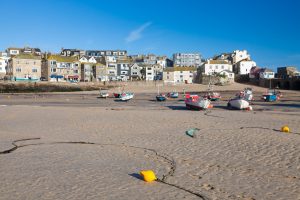
Eventually, we drag ourselves away from the pleasures of the beach and walk along to St Ives Head, from where we get a clear view of the Godrevy Lighthouse across the bay, a white vertical dash on the horizon, on which Virginia Woolf’s ‘To the Lighthouse’ was based. “For the great plateful of blue water was before her; the hoary Lighthouse, distant, austere, in the midst …”
The walk to Zennor is heaven. Lawrence describes it perhaps best of all: ‘The heather is all in blossom: there are very many blackberries, heavy on the briars: we got some mushrooms on the cliffs yesterday, small and round in the close grass: the sea was very beautiful, dark, dark blue, with heavy white foam swinging at the rocks’.
Wicca Cliff
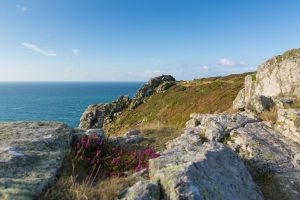 We reach the cliff above Wicca Pool, a perfect spot. The granite for St Ives Church was quarried here in the 1400s and then transported back by boat.
We reach the cliff above Wicca Pool, a perfect spot. The granite for St Ives Church was quarried here in the 1400s and then transported back by boat.
Lawrence and Frieda often came here for R & R. All they had to do was walk down alongside the stream from their cottage. It was also from this stream that they would have got their drinking supply, Lawrence would trudge out each day with a pail to the spring.
‘I remember once sitting on the rocks with Lawrence, by the sea, near our cottage at Tregerthen. I was intoxicated by the air and sun.’
It was also along this stretch of coast that Lawrence recalls: ‘A Spanish coal vessel (Manu), three thousand tons, ran on the rocks in a fog, straight under the cottage. She was completely wrecked. Her coal washed ashore, and the farmers carried it up the cliffs in sacks.’
Zennor Head
We enjoy spectacular views in both directions when we head out onto Zennor Head. Virginia Woolf walked this way many times and often paused at Gurnard’s Head (to our west), where she and a friend ‘sat and surveyed the boats and smelled the gorse and noted the wild flowers, and Virginia satiated herself in the perfumes of Cornwall.’
Zennor
A short, sheltered path takes us inland a few hundred yards to the tiny hamlet of Zennor.
‘Primroses and violets are out, and the gorse is lovely. At Zennor one sees infinite Atlantic, all peacock-mingled colours, and the gorse is sunshine itself, already.’ (Lawrence)
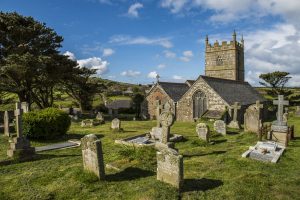 First, we visit St. Senara’s Church and learn about the popular Cornish folk tale The Mermaid of Zennor – we take a look at the ‘mermaid chair’ and read about the love between a beautiful mermaid and a local man with a divine voice, which has inspired many poems and lyrics.
First, we visit St. Senara’s Church and learn about the popular Cornish folk tale The Mermaid of Zennor – we take a look at the ‘mermaid chair’ and read about the love between a beautiful mermaid and a local man with a divine voice, which has inspired many poems and lyrics.
Then we pop into the cosy Tinners’ Arms for a swift pint. Built in 1271, its original purpose was to accommodate the masons who constructed St Senara’s Church. Its name derives from the fact that tin mining took place around here for many centuries. We learn that Lawrence & Frieda stayed in one of the rooms upstairs for a couple of weeks before moving into Tregerthen Cottage, and the mining associations must have reminded him of his Nottinghamshire birthplace.
‘We have been here nearly a week now. It is a most beautiful place: a tiny granite village nestling under high, shaggy moor-hills, and a big sweep of lovely sea beyond, such a lovely sea, lovelier even than the Mediterranean… It is the best place I have been in, I think’.
Zennor also meant a lot to Virginia Woolf. She lodged here in 1921 and wrote: ‘This is the loveliest place in the world. It is so lonely.’
Tregerthen Cottage
Feeling a tiny bit soporific, we take the field path northeast towards Tregerthen. The Lawrences would have taken this walk many times on their way back from picking up provisions at the village’s grocery shop (now a private house) which was attached to the old post office. They very much enjoyed the old lady’s buns and saffron cakes. It was coming back from just such a provisioning in 1917 on ‘the field path above the sea’, that Lawrence & Frieda were searched by the authorities on suspicion of being spies. Their knapsack was judged to be harbouring a camera, but it turned out to be just a bag of salt.
Tregerthen Cottage, their home from 1915-1917, is just up the track from Lower Tregerthen Farm, beneath the hill. ‘High pale hills, all moor-like and beautiful, behind, very wild’’ (Lawrence).
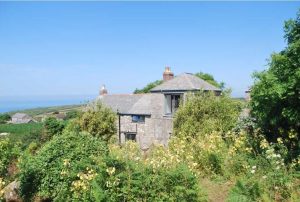 The cottage is easy to spot because of its distinctive square tower that was the Lawrences’ bedroom. Frieda observed: ‘Upstairs is a good bedroom with a great window looking down at the sea – which is six fields away.’ Inevitably, it is also very exposed to the Atlantic weather; ‘And how the winds from that untamed sea rocked the solid little cottage.’
The cottage is easy to spot because of its distinctive square tower that was the Lawrences’ bedroom. Frieda observed: ‘Upstairs is a good bedroom with a great window looking down at the sea – which is six fields away.’ Inevitably, it is also very exposed to the Atlantic weather; ‘And how the winds from that untamed sea rocked the solid little cottage.’
Lawrence became a keen vegetable gardener, partly for the pleasure and partly ‘needs must’ as they were very short of money at the time: ‘ I have three gardens: the little one, which is a gem: pansies and columbine and fuchsia as well as veg: then the little field at the back…broad beans, etc., spinach, many beautiful rows: then in the field below, peas, beans, etc. I have worked hard.’
On the map today, it’s marked as Tower House, Higher Tregerthen. Its location and quirkiness attracted a series of famous writers. In 1919 Virginia Woolf and her husband also rented this same cottage, having heard about its beauty from Katherine Mansfield, and many years later Michael Morpurgo did too! Several of his stories are based on Cornish folklore, and he wrote ‘The White Horse of Zennor’, a set of five short stories based around the village.
Eagle’s Nest
We continue to climb up the hill and turn left at the top past Eagle’s Nest, a large sprawling home on a rocky crag just to the left of Tregerthen Cottage, with beautiful gardens. Virginia Woolf stayed here on many occasions in the 1920s, and subsequently, the abstract artist Patrick Heron lived here. The neighbouring Old Poor House belonged to the celebrated garden designer Gertrude Jekyll in the 1890s.
It’s hard to believe what a concentration of artistic and literary talent lived in and was inspired by these two houses and their landscapes.
The field path home
We continue on the path past Tregerthen Farm. Lawrence became very friendly with the Hockings who lived here and used to help around the farm and with the harvest. The family reminded him of his youth and ‘The Haggs’ (Sons & Lovers).
The path we are now taking is known as the Zennor Churchway or Coffin Path and runs all the way back to St Ives across the flat ‘bench’ cut into the granite by waves when sea levels were higher. The path was marked by a number of round-headed wayside crosses that date back to the early mediaeval period, fragments of which still survive, usually in the form of a roughly trimmed boulder containing a square hole to take the cross shaft. There are also several granite stiles that we climb over, some of which were used as resting spots where the coffin was prayed over and blessed.
We are passing through small stone-walled fields that were first laid out by prehistoric farmers –amongst the oldest continually-worked landscapes in the country.
On this final leg, we stop for our ‘crowst’ (Cornish dialect for an outdoor tea or snack) on one of the granite stiles, just as Lawrence did when he helped with the harvest and the Hocking sisters brought out tea to the field in the afternoon.
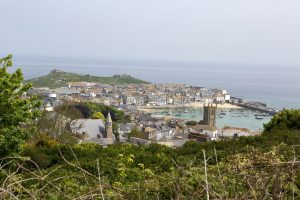
OTHER STUFF
- Read: The Nightmare chapter in ‘Kangaroo’, by DH Lawrence, which describes their time in Cornwall and their eviction
- Read: Frieda Lawrence, ‘Not I but the Wind’ (1934), autobiography
- Read: ‘Virginia Woolf & Vanessa Bell: A Childhood In St Ives’ (2014), author Marion Whybr
- Read: ‘Zennor in Darkness’ (1993), Helen Dunmore
- Stay: At Rananim Air B&B in Higher Tregerthen (next door to Tregerthen Cottage)
- Visit: The Godrevy Lighthouse by boat, St Ives Boat Services
- Visit during: the St Ives Literature Festival in May each year
- Visit: Zennor Quoit, an imposing Megalithic tomb high on the moor in a desolate, windswept position.

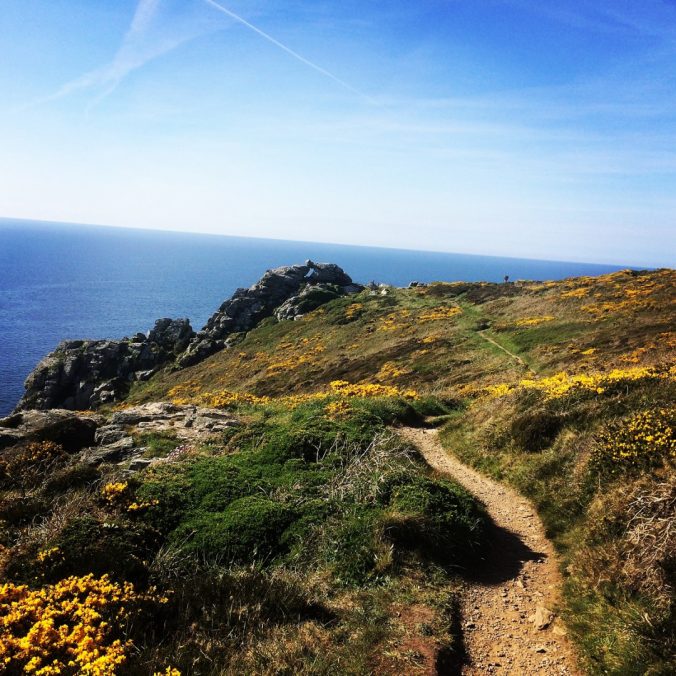
0 Comments
1 Pingback